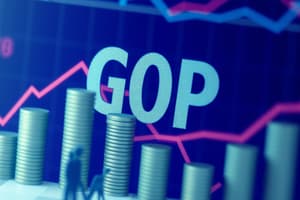Podcast
Questions and Answers
Flashcards are hidden until you start studying
Study Notes
Definition of Macroeconomics
- Branch of economics analyzing the economy as a whole.
- Focuses on aggregate measures rather than individual markets.
Key Concepts
-
Gross Domestic Product (GDP)
- Total value of all goods and services produced in a country over a specific period.
- Measures economic activity and growth.
-
Unemployment Rate
- Percentage of the labor force that is unemployed and actively seeking employment.
- Types: frictional, structural, cyclical, seasonal.
-
Inflation
- Rate at which the general level of prices for goods and services rises.
- Measured by Consumer Price Index (CPI) or Producer Price Index (PPI).
-
Monetary Policy
- Actions taken by a country's central bank to manage money supply and interest rates.
- Tools include open market operations, discount rate, and reserve requirements.
-
Fiscal Policy
- Government spending and tax policies to influence economic conditions.
- Aims to manage economic downturns or booms.
Economic Indicators
- Leading Indicators: Predict future economic activity (e.g., stock market returns).
- Lagging Indicators: Reflect trends after the economy has begun to follow a particular pattern (e.g., unemployment rates).
- Coincident Indicators: Occur at the same time as the conditions they signify (e.g., GDP).
Economic Models
- IS-LM Model: Represents the interaction between the goods market (Investment-Savings) and the money market (Liquidity preference-Money supply).
- Aggregate Demand and Supply: Framework to understand total demand in the economy and total supply of goods and services.
Business Cycles
- Fluctuations in economic activity characterized by phases:
- Expansion: Economic growth and increasing employment.
- Peak: Height of economic performance before decline.
- Contraction: Decline in economic activity and employment.
- Trough: Lowest point of economic activity before recovery.
International Macroeconomics
- Examines economic interactions between countries.
- Key concepts include exchange rates, balance of payments, and trade policies.
Major Theories
- Keynesian Economics: Advocates for active government intervention in the economy to manage demand.
- Classical Economics: Emphasizes self-regulating markets and the importance of supply-side factors.
Challenges in Macroeconomics
- Economic forecasting and modeling complexities.
- Trade-offs between inflation and unemployment (Phillips Curve).
- Globalization's impact on local economies.
Policy Debates
- The effectiveness of fiscal vs. monetary policy.
- Long-term vs. short-term economic strategies.
- Impact of government regulation and intervention in markets.
Definition of Macroeconomics
- Analyzes the economy as a whole, rather than individual markets.
- Emphasizes aggregate economic measures like GDP, unemployment, and inflation.
Key Concepts
-
Gross Domestic Product (GDP)
- Represents the total value of goods and services produced within a country over a given time.
- Serves as a key indicator of economic activity and growth.
-
Unemployment Rate
- Measures the percentage of the labor force that is actively seeking employment but is currently unemployed.
- Includes types such as frictional (temporary), structural (mismatch), cyclical (economic downturn), and seasonal (time-based).
-
Inflation
- Indicates the rate at which the general price level for goods and services rises.
- Commonly measured by the Consumer Price Index (CPI) and Producer Price Index (PPI).
-
Monetary Policy
- Comprises actions by a country's central bank aimed at controlling the money supply and interest rates.
- Key tools include open market operations, adjusting the discount rate, and setting reserve requirements.
-
Fiscal Policy
- Involves government strategies related to spending and taxation to influence macroeconomic conditions.
- Aims to stabilize the economy during downturns or booms.
Economic Indicators
-
Leading Indicators
- Predict future economic activity, such as stock market performance.
-
Lagging Indicators
- Reflect past economic trends and performance, e.g., unemployment rates.
-
Coincident Indicators
- Occur simultaneously with the economic conditions they represent, such as GDP measurements.
Economic Models
-
IS-LM Model
- Illustrates the interaction between the goods market (investment and savings) and the money market (liquidity preference and money supply).
-
Aggregate Demand and Supply Model
- Framework used to analyze total economic demand and the overall supply of goods and services.
Business Cycles
- Characterized by fluctuations in economic activity through distinct phases:
- Expansion: Period of economic growth and increasing employment.
- Peak: Maximum economic performance preceding a decline.
- Contraction: Period of decreasing economic activity and rising unemployment.
- Trough: Lowest point in economic performance before recovery initiates.
International Macroeconomics
- Studies economic interactions among different countries.
- Key focus areas include exchange rates, balance of payments, and international trade policies.
Major Theories
-
Keynesian Economics
- Advocates for active government intervention to manage demand and stabilize the economy.
-
Classical Economics
- Highlights the importance of self-regulating markets and the role of supply-side factors.
Challenges in Macroeconomics
- Complexity in economic forecasting and modeling can hinder accurate predictions.
- The Phillips Curve illustrates the trade-off between inflation and unemployment.
- Globalization affects domestic economies and complicates macroeconomic assessments.
Policy Debates
- Discussion centers around the effectiveness of fiscal versus monetary policy in managing the economy.
- Long-term strategies may differ significantly from short-term actions in addressing economic issues.
- The role of government regulation and intervention in various markets remains a contentious topic.
Studying That Suits You
Use AI to generate personalized quizzes and flashcards to suit your learning preferences.




